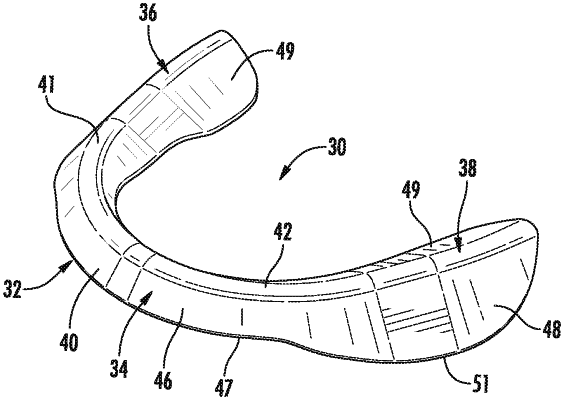| CPC A61F 5/566 (2013.01) [A61F 2005/563 (2013.01)] | 24 Claims |

|
1. A dental guard for treatment of bruxism in a human dental arch having a width and including a plurality of anterior teeth and posterior teeth having outer surfaces and occlusal surfaces, the dental guard comprising:
an elastically deformable body formed from a flexible resilient material and having a front band portion, and a pair of molar portions contiguous with and extending from ends of the front band portion to distal ends of the pair of molar portions, the front band portion and the pair of molar portions of the body forming a U-shape, the body including
a front side wall having a smooth inner surface and a longitudinal edge, wherein the body is planar along the longitudinal edge of the front side wall, and
an upper side wall having a smooth inner surface, the upper side wall extending at an angle from the longitudinal edge of the front side wall such that prior to use the longitudinal edge defines a first angle between the inner surface of the front side wall and the inner surface of the upper side wall, wherein a distance between the longitudinal edge of the front side wall at the distal ends of the pair of molar portions is dimensionally stable in a plane including the longitudinal edge of the front side wall and is configured to differ from the width of the human dental arch,
wherein when the jaws are open the body is adapted to be positioned to fit over the plurality of teeth in the human dental arch such that the inner surfaces of the front wall and the upper wall engage the occlusal surfaces of the posterior teeth,
wherein when the jaws are closed the body flexes such that the longitudinal edge defines a second angle between the inner surface of the front side wall and the inner surface of the upper side wall, and the molar portions rotate in the plane for at least partially conforming the front side wall to the outer surfaces and the upper side wall to the occlusal surfaces of differently sized and differently shaped teeth corresponding to different people during use, and
wherein the angle defined by the longitudinal edge between the inner surface of the front side wall and the inner surface of the upper side wall returns to the first angle upon removal of the body from the dental arch.
|